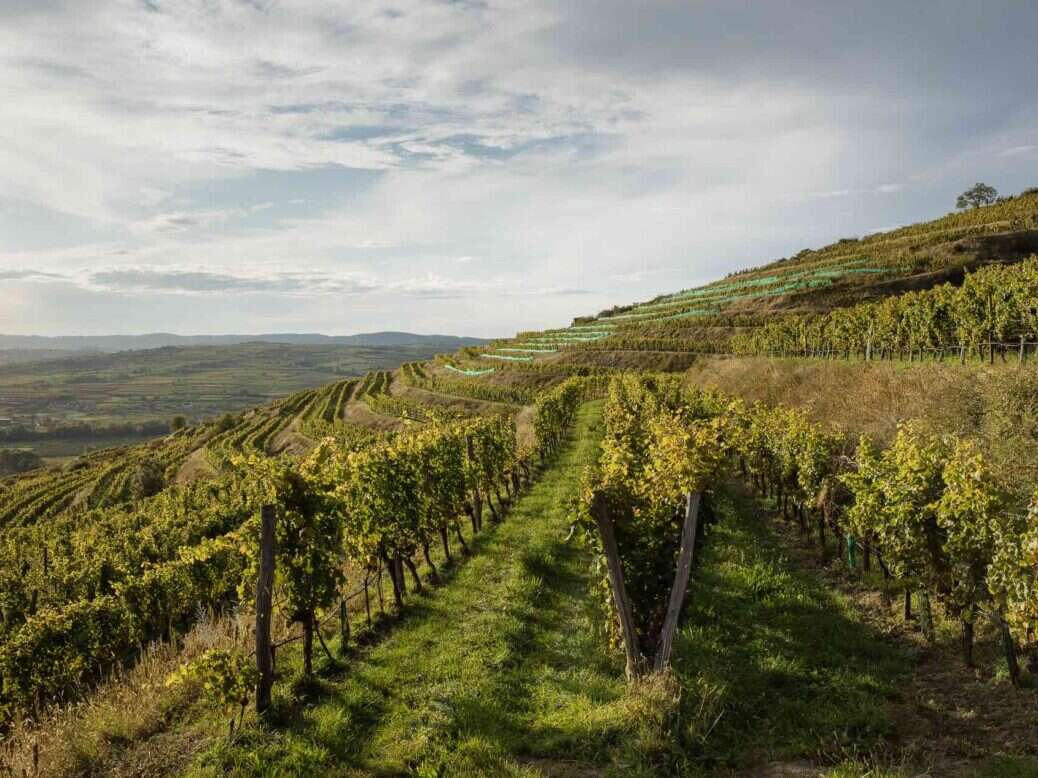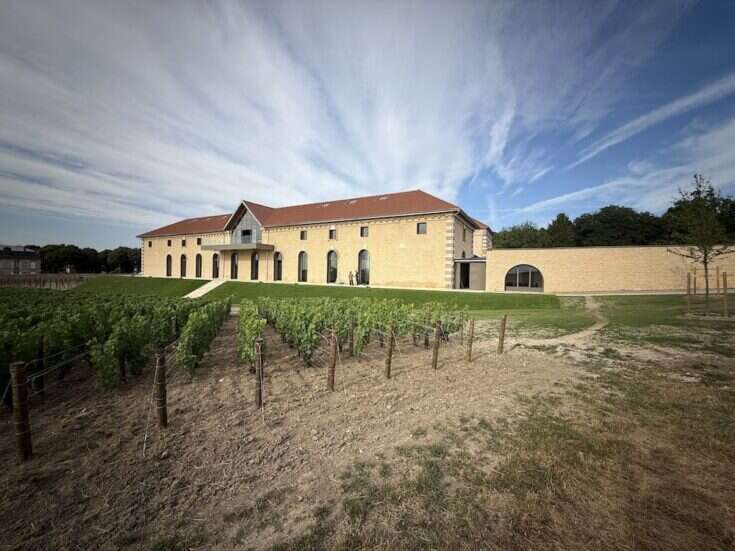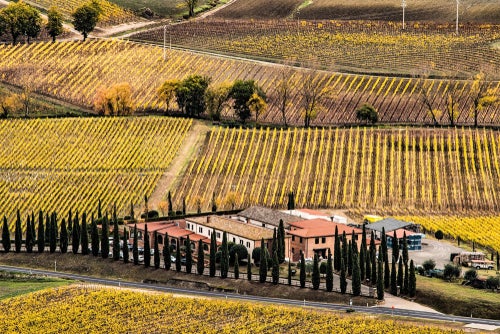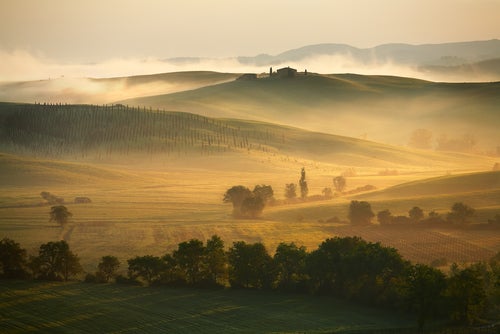
In the second part of his in-depth engagement with the latest releases from the great Kamptal estate, Terry Theise is impressed anew by the 2020 and 2019 vintages of Bründlmayer’s diverse portfolio of Grüner Veltliner.
2020 Kamptal “Terassen” Grüner Veltiner +
I tasted this before, from an open bottle (mostly still full, opened that day), and wrote this: “Finely detailed lentilly aroma. Generous mid palate for a ’20, and while the finish is washed with scree, it isn’t sharp. This is effective, sensible winemaking; the wine has either been cressy (at times too much so) or ‘yellower’ (oleander, meadow-flowers) but this one straddles the line smartly. “Aromatically ‘giving.’ One plus, as it does everything an ‘ace’ estate ought to do.”
Now I have a bottle of my very own! And it’s a sorrelly beauty. Aficionados of spring herbs know that wild sorrel can show an esoteric sweetness, like a marriage of cress and key-lime and wintergreen, and this rare and refined aroma is available to very few wines. But we find it here.
Willi knows me a long time, and he knows (ruefully) that this wine sometimes frustrated me, in vintages when I found it too austere. I liked the ripe, “yellow” ones, but this ’20 is the best example of a (ripe!) “green” vintage in my almost 30 years’ association with these wines. It is a lyric of leaves! It is so detailed and has so much of what I sometimes call “secret” sweetness—and so much sheer class—that I wonder if this price-point can possibly offer a finer wine. Not just a finer Grüner Veltliner: a finer wine.
In principle you encourage complexity by mixing fruit grown on loess along with its counterparts from primary rock. Loess gives what I call the “wet-cereal” aroma, and primary rock the minerality, and this vintage is an example of the 1+1=3 principle of blending, offering flavors different from the sum of their parts.
2020 Ried Berg Vogelsang Grüner Veltliner ++
An unheralded site mostly on (so-called) Gföhler gneiss with amphibolite rocks scattered around, the wine can either be markedly peppery or else—as here—intriguingly suave and cressy. And this vintage has just the sweetest aroma! Actually, sorry, I mean clearly I shouldn’t say this, but it’s one of those wines where if you taste it and still deny that Grüner Veltliner is a great variety, then you are just terminally hopeless, is all any thinking person could say. And it’s a “little” wine at 12.5% alcohol!
The green beans that grow in heaven would smell like this. The serene energy and effortless detail of this wine are barely accessible to most other wines. OK, lima beans, hyssop, chervil, dill, sweet marjoram, radish, ginger, and on and on, different with each inhale. A nearly perfect wine occupying the terra incognita between the “Great” (which we lunge toward) and the “Everyday,” this is the place where genius is found.
Having written those words, I admit I approached the second tasting with some wariness. I’ve been known to take a shortcut to euphoria, oh … from time to time. Today I’d observe that the sweet top-note of the wine has absorbed itself into the omnipresent chlorophyll-y green. It’s the gorgeous reek of spring apart from the flowers. The wine remains a masterpiece in miniature, and I can’t help responding to its charged, pulsing quietude.
2019 Ried Loiserberg Grüner Veltliner
Though this is the “great” vintage, I’ll be sorry to leave the ‘20s.
One hears various things about this vineyard. Bründlmayer’s website describes it thus: “The soil is mainly a rocky, non-calcareous brown earth that overlies a variety of siliceous crystalline rocks such as paragneiss, mica schist, and amphibolite, except for areas where these rocks are covered by loess (which thickens towards the southeast) and the occasional marble outcrop.”
Often this feels like the Grüner Veltliner for Riesling lovers, but the ’19 offers aromas that don’t refer to either variety, but rather to oleander, mimosa blossoms, vetiver, and flowering fields. The palate is improbably rich for what is usually a streamlined wine, which may have influenced some suspiciously high “scores” from other reviewers. It’s an outsized Loiserberg, strong but turbulent, with a lot of “sound” but rather like an orchestra playing while the audience files in to take their seats.
Yet there may be something here. I’ll observe it over the days to see if it knits or if it’s just some crazy skein of flavors with no organizing principle. Another grower cautioned me to watch out for 2019s, which “are sometimes in one of their moods,” he said.
But who knows? Tasting it again I remember the vintages I’ve liked, the cool ones, crisp and verdant and mineral. Don’t take this the wrong way, but this very good wine is something of a mess. I like the haricot vert thing, and the overall mood of voodoo, and the end-palate firmness is a hopeful sign. I wonder whether it will gather itself and stop flopping around.
2019 Langenloiser Alte Reben Grüner Veltliner +
In principle a cuvée of various parcels of very old vines, creating a sort of hybrid-vigor of different soils. Formerly just known as “Alte Reben,” the commune name was mandated by the DAC regulations. Note also the visual symbol of the Burgundy bottle.
Often this was the relatively affordable entrée into the world of the outsized Grüner Veltliners. You’d taste wood now. The best vintages would poise the woodsy tertiary flavors against a primary pepperiness and the results could be galvanizing—with the proper age. To our benefit the estate offers back-vintages, which I always sought out, a practice I hope goes on.
This is potentially wonderful Grüner Veltliner, especially as tasted from the Jancis glass. In a way I can’t bear to taste it, but would rather sit on the deck on this arrestingly fresh late-July day and just contemplate it. A lot of atmospheres to inhale in a wine like this. Occupying as it does, the vestibule to the Giants, it shows a certain lift, yet it’s one of those wines, if you tasted it blind, you couldn’t say if it was red or white.
Second look: This time I introduced the MacNeil “Creamy & Silky” glass to the process. From that glass the wine totally hugs you, and who doesn’t love a hug? From the Jancis it whispers to you, which is also exquisite. We get to select our version of the truth, understanding that each is a partial truth. I prefer the articulation of the Jancis in this case, but that’s because it’s so compelling I don’t notice missing the hug. There’s an odd iron length tasting right from the bottle, absent from either glass’s expression. Regardless, the wine is lovely, but its “truth,” how it “really” tastes, remains obscure and contingent. But in each of the inputs there is a tender strength I find wonderful.
2019 Ried Spiegel “Vincent” Grüner Veltliner +
Willi’s son Vincent obtained the vineyard in 2010, but since 2018 he’s stepped away from day-to-day involvement with the making of the wine. In any case the vineyard is large, deep, and calcerous, and the wines can be either medium-weight, firm, and muscular or outsized and capacious, according to the preference of the vintner. This bottling has tended to the large-scaled and stolid. In earlier times it contributed to the “Alte Reben.”
I admit to a certain wariness about this wine, but I also admit the ’19 is pretty damn impressive. It has that Grüner Veltliner crossing-over to white Burgundy thing going on, but no white Burgundy has this implacable solidity. It’s like a meat made out of hay, or like really fresh oyster mushrooms; it’s a ’19 that makes a believer out of me. This wine has sometimes troubled me with its affectations, but now it grasps what it reached for, and it lands on some elemental Veltliner-ness that was obscure to earlier vintages. And while it is certainly intense it’s also surprisingly light on its feet. That deftness is underscored from the Jancis, which is the glass for this wine, one of the few times where one is certain—yup: this is the best. It reveals the underlying stoniness explicitly, and now the richness of body both makes sense and is part of a dialectic.
It’s a high-water mark for this wine that smells, among other things, like a roasting chicken the moment you notice, “Wow, the bird smells good.”
This wine is sometimes considered avant garde but I don’t find it so. It is rather a classic vein of Grüner Veltliner, spun out to its limit.
I have to interject. This isn’t about “wine,” so skip ahead. We have clear air today, Canadian air arriving on a northwest wind. No smoke from the fires out west. The clouds are outlined in detail. All the rain we’ve had, the garden is going happily apeshit, and even our “lawn,” such as it is, is a crazy shade of green. I paused outside with this wine, and the liquid blue sky and the psychotic white clouds and the plants engorged with watery life and even the silly emerald grass, and I put my nose in the glass and almost sobbed at all this aching lostness, all this world, this simple world, the square meters of it at the edge of my dwelling, and let me warn you this won’t be profound, but I thought “in all this beauty and peril, people go on making wine as though beauty would save us.”
I don’t know, maybe it will. Something has to.
2019 Ried Käferberg Grüner Veltliner +
Willi took us up there one year—“us” being my wife and me—because Karen-Odessa had asked for a spot from which she could walk back down to the winery. (I taste, she walks.) So I have it imprinted—also as the place from which the sometimes too-big wines hail. According to the website, “The soil here differs from that of all other sites in the region. At the 300m (984ft) level, preserved calcareous, clayey marine deposits are found. This soil is similar to that of the famous Château Petrus in Pomerol, and produces an extremely dense wine, although it is difficult to work with.”
This is another instance of 2019 surmounting my wary objections. The wine is excellent. It’s strong, to be sure, but not clunky or fatiguing. Käferberg is a big strong dog who pulls you around when you go out walking, but she’s a tail-wagging friend to everyone she encounters. I could regale you with “The Flavors,” but it’s enough to say it’s an amalgam of big-ripe Grüner Veltliner with unusually firm white Burgundy—though with a fervid note of licorice I don’t know how to account for—and I really wonder … does this ’19 offer an (unusual) structure the estate intended, or is it the vintage? Because I’d love to think this is the future for Käferberg; smoky and exotic (and a little reduced?) yet also firm and high-register and spooning a warm liquid straw over your palate.
It changes little on second encounter. How much you love it will depend on your tolerance for assertiveness. MacNeil’s glass tempers the thrust somewhat, at the cost of a brilliance you may or may not require. It’s a big strong wine that isn’t oafish or crude.
2019 Ried Lamm Grüner Veltliner +++
In some circles “Bründlmayer Lamm” has the same resonance as “Mugnier Musigny” or “Leflaive Montrachet.”
Accordingly we who know it are wont to approach it … almost warily. Is it really all that great? Again???
I’m struck first by the alcohol—only 13%. This is not common.
The fragrance is miasmic and staggering. There’s a fluidity I now see is missing from Käferberg, fine as it is.
There is a deep, deep savor that has nothing to do with anything discrete we can cite: Not with “grape variety” or “cellar regime” or even “soil composition,” but is rather one of those enigmas by which we are either frustrated or galvanized.
It is also one of those rare wines we feel can be happily drunk now but which will age without complication for as long as you can bear to wait. I have been tasting calmly all afternoon, duly (if reluctantly) spitting, but this is today’s final wine and damn if I won’t swallow it.
The Icon is always under pressure to earn its place again, year after year. Bründlmayer Lamm Grüner Veltliner is one such (among several from this estate) and we can well ask, has it warranted its place every year? To which I’d answer: more often than not—and these are not machines that can replicate a given result, but human beings coping with the caprices of nature. And so “more often than not” constitutes a triumph, and among these temporal victories none is more profound than this truly heartening and astonishing Lamm Grüner Veltliner from 2019.
I haven’t told you what it tastes like, but that isn’t so simple to do. You have the Lamm rusk, the rye-dough, even the rare lamb-meat itself (though “Lamm” has nothing to do with baby sheeps), and it has a marmalade-y fluidity, and if I said “rhubarb-beets-wintergreen” and some other taster said “allspice, pink peppercorns, verbena,” we’d both be wrong and we’d both be right. Both of us might say “wood” but we’d agree the wood is enfolded into the omnipresent juiciness. The wine is a modest heroine, she prevails by guile and grace and cleverness and determination while all the guys around her are busy beating each other up.
I apologize, I know some of you hate “gender” attributes ascribed to wine, but this “she” glides along as no man could. She is a slippery bliss. She is every scintilla of profundity without an ounce of preening strength. She is echoes, kiss-breath, she is the shape of the neck when a swan bows its head.
I have only ever had two Austrian wines that approached the ethereality of Raveneau—one from Bernhard Ott, and this one. With wines like these, you sit with them, and they show you the world.
For more of Theise’s thoughts on Bründlmayer’s latest releases, click here for the red and sparkling wines and here for the Rieslings.
A note on scores by Terry Theise
I disapprove of points. I don’t recognize measuring wines against a notion of “perfection,” I think it’s a fool’s errand to assign absolute value to an ephemeral impression, and the more precise a scoring system purports to be, the more it actually misleads.
That said, my mind forms hierarchies of its own volition, and special wines warrant special attention. So I’ll revert to my deliberately inexact system of plusses—one, two, or three—to recognize the most remarkable wines. My plusses are sort of like Michelin stars. One plus is a wine that stood out. Two plusses is a wine that made me stop and consider the depth of its beauty. Three plusses is a wine that tingles with greatness, and offers a moment of profundity. Feel free to superimpose whatever scoring system you deploy; the point-systems are harmful but the folks who use them aren’t evil, so if you want to conflate my three plusses with a scoring range that makes sense to you, be my guest.
Extracted with permission from Terry Theise’s Tasting Protocols.






